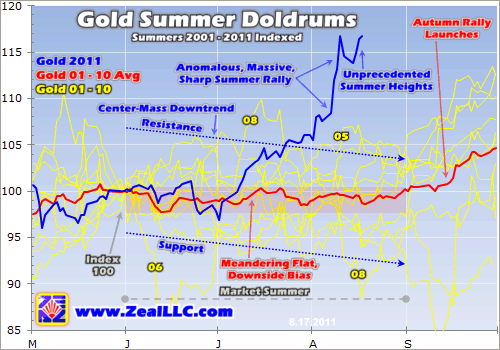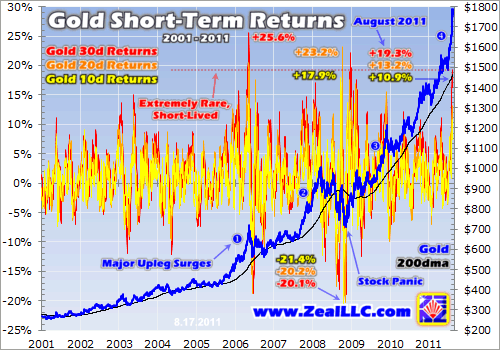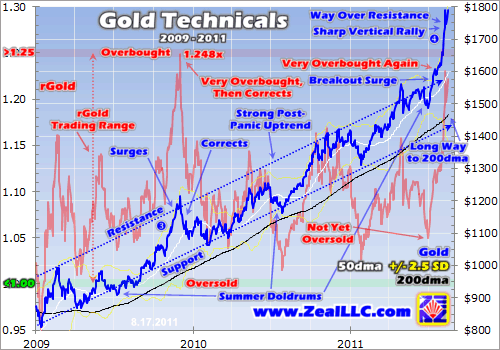|
|
|||||||
|
|
|
|
|
|
|
|
|
|
Gold Overbought Adam Hamilton August 19, 2011 2948 Words
Gold has enjoyed an amazing rally in recent weeks, catapulted higher by the extreme fear sparked by the sharp stock-market correction. Naturally such big and fast gains have led to a surge in gold’s popularity among investors and speculators, as everyone loves a winner. But gold prices flow and ebb like everything else, and this metal has become very overbought today.
Many gold enthusiasts’ hackles will bristle at the mere idea of gold being overbought. They will counter with many fundamental reasons why gold is heading higher, or argue that current newsflow will spark escalating buying. But gold’s long-standing bullish fundamentals do not override short-term technicals. When any price rallies too far too fast, including gold’s, the odds balloon for an imminent retreat.
As a hardcore contrarian, I started recommending physical gold coins to our subscribers as long-term investments way back in May 2001 when gold was universally loathed. It traded under $265 per ounce then! Over the long decade since, though gold has indeed powered higher on balance in a mighty secular bull, it has still weathered many corrections and consolidations after getting too overbought.
And at the eves of every one of these necessary selloffs to rebalance away excess greed, the majority of traders were wildly bullish. After any big and fast move, in any market, near-term enthusiasm waxes extreme. Traders’ collective bravery peaks near major highs, where they should be afraid of healthy selloffs. And if you follow the financial media, you know the love for gold today is pretty overwhelming.
Though sentiment is ethereal, impossible to directly measure, the price action that drives it is concrete. I suspect any technical tool you want to use will reveal gold to be very overbought today. Consider seasonals for example. Gold tends to drift sideways in the summer due to a lack of major income-cycle and cultural drivers of outsized investment demand. Obviously this hasn’t been the case this year!
This first chart is updated from my PM Summer Doldrums 3 essay of early June. It takes each summer’s gold action in this secular bull and indexes it individually to the last trading day in May. This enables us to compare every gold summer in perfectly-comparable percentage terms. The yellow lines are each summer from 2001 to 2010, the red line is the average gold performance of all these past summers, and the blue line represents 2011’s indexed gold action.
Summer 2011 initially began like most other summers, with gold meandering sideways to lower. But after bottoming in early July, gold started to rally. You remember the primary catalyst, the debt-ceiling debate in the US Congress was heating up. Though it was still a month until the Treasury’s August 2nd deadline for avoiding the first-ever US default, the fiery rhetoric started ramping anxiety.
The core fight over excessive government spending was simple. If you compare the average of Obama’s first 3 budgets with George Bush’s last 3, Obama grew federal spending by a gargantuan 28%! And this is saying a lot since Bush was a big spender too, making him very unpopular among fiscal conservatives. Obama orchestrated this massive federal-government growth during recessionary years where tax revenues were 11% lower on average. The result? A quintupling of Washington’s deficit to an insane $1.25t per year, and a 43% increase in the US national debt in less than 3 years of Obama!
Republicans wanted to rein government spending back in line with half-century averages in proportion to US GDP, while Democrats wanted to lock in Obama’s unprecedented government growth as the new normal going forward. As the Treasury’s early-August deadline loomed nearer and anxiety mushroomed, capital gradually migrated into gold. This drove rare sustained outsized investment demand in the summer months.
By the end of July, gold was 6.0% above its pre-summer May close. While this was a bit over the center-mass downtrend’s resistance as you can see above, it was still fairly normal for a gold summer. But all this changed on August 2nd when the stock markets sold off sharply despite a debt-ceiling deal being approved at the last minute. The S&P 500 plunged 2.6% and gold blasted 2.3% higher on safe-haven demand.
After that, it was off to the races over the past couple weeks. Gold rallied the most on days the stock markets were the weakest. And with plenty of huge down days in the stock markets, flight-capital demand for gold drove a series of outsized up days for this metal. The result is readily evident above, an anomalous, massive, and sharp summer rally. This drove gold to unprecedented summer-rally heights in August, much higher than anything yet seen in this entire secular bull.
By the middle of last week, gold had soared 20.4% higher in just over 5 weeks! It was up 16.7% on the summer, 36.5% since its 2011 lows in late January, and 26.2% year-to-date. These are super-fast moves for this giant asset. Are such huge gains over such a short period of time sustainable? They sure haven’t been in gold’s secular bull to date! This next chart shows gold’s 10-trading-day, 20-trading-day, and 30-trading-day returns throughout its entire decade-long bull.
By the middle of last week, gold’s 10d, 20d, and 30d gains ran way up at 10.9%, 13.2%, and 19.3%. This is hard to interpret without context, but this chart reveals just how rare such fast gains are. If you visually extend the latest yellow, orange, and red peaks back over the past decade, you can see that today’s levels are extremely rare and short-lived. Gold has never been able to sustain gains at such a blistering pace.
While gold’s latest big gains aren’t its best of this bull, after every prior big-gains spike gold soon fell sharply. Though these selloffs didn’t always last long, and weren’t always of correction-magnitude, they still happened like clockwork. Gold simply can’t sustain massive gains on the order of 10% over 2 weeks, 15% over 4 weeks, and 20% over 6 weeks. These are levels where gold is too overbought to continue rallying.
Overbought simply means a price has rallied too far too fast. It has nothing at all to do with absolute levels. Gold at $1800 might be perfectly reasonable given its global fundamentals, and its price will probably be considerably higher by the end of this year. But over the short term, in the coming weeks or couple months, gold will likely face some serious selling pressure after such a super-fast advance. These post-spike selloffs are purely psychological and are totally unrelated to fundamentals.
When any price rallies too far too fast, traders get too excited and greedy. These big gains lead everyone interested in buying that asset to chase the rally. But soon everyone interested in buying in anytime soon has already deployed their capital. With all the near-term buyers in, buying pressure is exhausted and greed burns itself out. At that point prices top and any selling at all overwhelms the dearth of buyers. The result is a fast plunge that crushes greed, sparks fear, and rebalances sentiment. This is very healthy.
Why couldn’t gold surge even higher first before correcting? Why not up 30% in 30 trading days? Just because it hasn’t happened yet in this bull doesn’t mean it can’t happen, right? Gold could indeed become even more overbought, there’s no doubt. But odds are it won’t. One of the key reasons the big short-term gains in this chart are never sustainable is the sheer colossal size of the global gold market.
According to the World Gold Council, about 170,000 metric tons of gold have been mined in all of world history. Though a little has been lost (unrecoverable shipwrecks, electronics, dental work), the vast majority is still around. Do the math and this works out to a staggering $9.8t worth of gold at $1800 per ounce! For comparison, at the end of last month the US MZM money supply was $10.1t, and all 500 elite companies of the flagship S&P 500 stock index had a collective market capitalization of $12.2t.
Gold is an unbelievably-big market these days, vast. And the bigger the market capitalization of any stock or asset, the slower it is to move. Just as a speedboat is far easier to turn than an oil supertanker, a small stock is far more volatile than a large one. And pushing $10t today (or even $7.2t back at its late-January lows), the collective value of the world’s aboveground gold supply is massive beyond belief. It is 25x larger than the biggest individual stock on the planet!
Such a gargantuan asset isn’t likely to move very fast, so outsized moves to the upside or downside relative to gold’s bull-market history never last for long. In fact, as you can see above gold tends to bounce back sharply to overshoot the other way soon after any notable extreme. After excessive short-term gains gold tends to collapse to excessive short-term losses, and vice versa. This is why traders need to be wary of extremely-overbought conditions like we’re seeing in gold today.
Gold’s major upleg surges that culminate in sharp vertical rallies have always been followed by sharp selloffs. These can be corrections, but are usually just consolidations (sideways grinds). Today’s gold surge is the fourth major one of this secular bull, as you can see above. The other three climaxed in extreme short-term gains that soon collapsed into huge outsized losses as sentiment was rebalanced.
Another way to measure gold overboughtness is with my very successful Relativity Trading system. It simply renders gold as a multiple of its own 200-day moving average. This is valuable for a couple reasons. First, it measures gold’s uplegs in perfectly-comparable percentage terms over time despite ever-higher gold prices as this bull marches on. Second, this multiple tends to form a horizontal trading range over time. This chart shows Relative Gold (rGold) in light red (left axis) since the stock panic.
Over the past 5 years, rGold has tended to top around 1.25x. In other words, once gold rallies so far so fast that it stretches 25%+ above its 200dma, it is unsustainably overbought and an imminent correction is due. This last happened back in early-December 2009, when gold had “only” surged 15.1% in 30 trading days to hit 1.248x relative. What happened right after this surge to very-overbought levels? Gold immediately corrected, falling 12.6% over the subsequent 9 weeks into early-February 2010.
Back then I wrote an essay about gold being overbought the very week it topped. And as expected with any outlook contrary to popular consensus, that thesis ignited a firestorm of criticism and even ridicule. People accused me of being stupid, ignoring fundamentals, not paying attention to news, of being anti-gold, and worse. Though contrarian traders fighting the crowd earn massive profits, contrary opinions near extremes are never popular. But overbought prices soon correct, whether we like it or not.
It’s provocative that gold hasn’t even approached those December 2009 extremes in relative terms again until this past week! On Wednesday August 10th, gold surged 3.1% higher on a nasty 4.4% S&P 500 (SPX) down day, hitting a new all-time nominal high. But it was stretched to 1.231x relative, very overbought by its own bull-to-date standards. Then again on Thursday the 18th as I am writing this essay, another big SPX down day drove another big gold up day to even higher relative levels.
Can gold sustain being stretched 25%+ above its 200dma? Is enough new capital going to flood in right now to drive a $10t asset higher to even more-overbought extremes? Maybe, anything is possible in the markets. But based on gold’s bull-to-date precedent for summer behavior, absolute short-term gains, and stretching above its 200dma, the odds for this rally persisting are very low. And prudent successful traders never bet on low-probability-for-success outcomes.
Usually after seeing similar extremes to today’s, gold corrects back down to its 200dma. In the context of a secular bull, such 200dma approaches are common after major uplegs. They are no big deal technically from a long-term perspective, and are actually very healthy as they rebalance sentiment to extend a bull’s longevity. But in real-time, they feel incredibly brutal. Today gold’s 200dma is way down near $1465, 18.1% and $325 lower from its recent highs! Can you weather such a selloff unscathed?
And even if gold doesn’t make a 200dma approach after being so overbought this time, any conceivable correction level you want to mark on this chart is way lower from here. Merely to get back down to the upper resistance of its strong post-panic uptrend, gold would have to fall to $1600 or so. This is 10.6% and $190 lower than its recent highs! Very-overbought markets have lots of room to correct hard and fast, they slaughter those who trifle with these serious risks.
What could drive such a sharp gold selloff? The most-likely catalyst is a major stock-market rally. It sounds crazy I know, but after such extreme fear a huge stock-market rally is highly probable as I explained in my essay last week. Gold’s summer rally didn’t start surging and getting excessive until early August as the stock markets started plunging. This metal’s big up days in recent weeks corresponded exactly with big SPX down days.
Capital fleeing the stock selloff understandably flooded into gold, and inflows into the flagship GLD gold ETF empirically verified this. But as the stock markets inevitably bounce out of those extremely oversold and hyper-irrational lows, some of the capital that has been hiding out in gold will surely exit. Just as the gold buying pressure fed on itself in recent weeks, so will any selling pressure. As gold accelerates lower, more and more traders will get scared and start exiting their recent positions they bought near highs.
In the first 8 trading days of August alone, gold soared an unbelievable 10.1%! This created a trillion dollars of wealth! The SPX lost 13.3% over this exact span, driving the atypical summer surge of capital into gold. But after such anomalously-extreme selloffs, stock markets tend to bounce fast. If the SPX gains 10% in the coming weeks, again highly likely, will gold fall 5% or 10%? Probably. And the faster it drops, the more the selling will feed on itself and drive a sharp correction.
It is really pretty ironic to see gold overbought this time of year, as gold seasonals tend to bottom in the first half of August. Usually right now is one of the best buying opportunities of the year for this precious metal, as it is usually unloved and oversold after a demoralizing grind in its summer doldrums. So it does seem strange to see gold technicals predicting an imminent correction just as the strong autumn seasonals are due to begin.
But it is crucial to remember that seasonals are only secondary drivers at best. Sentiment, popular greed and fear, is always the primary short-term driver of any price while fundamentals are the primary long-term driver. Extreme greed necessitating a correction easily overrides any seasonality. But once this correction happens and sentiment is rebalanced, bullish seasonality can reassert itself. And though a gold correction off of today’s extremes is likely to be big and sharp, it ought to be relatively short-lived (weeks to a couple months at worst).
Being a contrarian is very challenging, it is hard fighting the crowd. It is stressful and wearying to buy stocks aggressively over the past few weeks while everyone else thinks the markets are heading into a new panic. It is no fun to see gold overbought and expect a selloff right on the verge of the big autumn buying season. I am going to get a blizzard of hate mail for this essay, mocking me to no end. Yet buying when others are afraid and selling when others are brave is the surest way to make a fortune in stocks.
We’ve been doing this publicly for over a decade at Zeal, with spectacular results. All 591 stock trades recommended in our newsletters since 2001 have averaged annualized realized gains of +51%! This includes all our losing trades, includes weathering the brutal 2008 stock panic, and was achieved in a massive decade-long sideways-grinding secular stock bear. If you want to rapidly multiply your wealth in the stock markets, you have to steel yourself to be a contrarian and fight the crowd.
If you’re tired of mindlessly buying high when everyone else is bullish and then selling low at the first sign of real fear, and perpetually losing money, you ought to subscribe to our acclaimed weekly or monthly newsletters. In them I explain what the markets are doing, why, and where they are likely heading next. They distill our vast knowledge, wisdom, and experience into high-probability-for-success trading opportunities in specific stocks. Subscribe today and start thriving in these crazy markets!
The bottom line is gold is very overbought today based on its own bull-to-date precedent. The combination of the debt-ceiling anxiety and an overdue and sharp stock-market correction drove rare outsized gold demand in the summer doldrums. But so much capital flowed into gold that it rallied too far too fast to be sustainable over the near term. A healthy correction is necessary to rebalance sentiment.
If the stock markets stoke more fear, gold may edge a little higher first. But sooner or later the wildly-oversold stock markets will bounce and some of the flight capital hiding in gold will exit. This selling will rapidly feed on itself, likely driving a sharp yet short-lived correction. If this comes to pass, investors and speculators alike should prepare for an excellent buying op early in gold’s strong autumn rallying season.
Adam Hamilton, CPA August 19, 2011 Subscribe |
|||||||
|
|
|
|
|
|
|
|
|
|
|
|
|
|
|
|||



